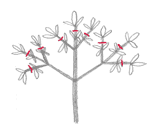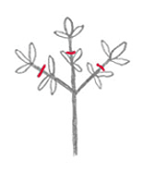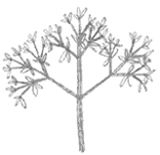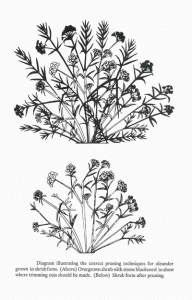OLEANDER CULTURE
Here is some helpful information from our handbook regarding Oleander Culture:
Plant Selection– For optimum results with oleanders, variety selection is a key factor. After identifying the variety best suited for the intended site, attempt to observe plants whenever possible prior to purchasing. Avoid plants labels as double white, single red, etc., and select only those that specify exactly which variety is offered for sale. This ensures that the small plant purchased will develop into the matured specimen intended for the site. Desirable plants have dark green leaves, the thick stems, and appear dense and bushy. Avoid plants with broken branches, yellow or necrotic. leaves, wounds on stems, or those having weak spindly stems. Examine for oleander gall and insects, especially aphids and mealy bugs. Containerized plants should not be pot bound, i.e. have over grown root systems consisting of dense roots completely encircling and obscuring the growing media. Instead, select plants that continue to retain the root mass intact when removed from the container, but also allow for some visibility of the growing medium.
Site Analysis & Preparation – Oleanders are adapted to a variety of sites within the landscape, but do best in full sun locations. Plants grown in partial shade will produce flowers, but less profusely. Although sparse blooming results from planting in dense shade, oleanders will survive in such areas.A wide variety of soil tides and moisture regimes are tolerated by the oleander, from dry sandy soils, to moist clay soils. Also, they are tolerant of soils with high levels of salt content.Oleanders make excellent wind breaks, but damage sustained by flowers during high winds can destroy both open blossoms and flower buds. Coastal plantings incurred salt damage to leaves in the form of leaf tip browning. Researchers (Hagiladi et al. 1989) reported the oleander to be moderately salt sensitive and that significantly less leaf scortch occurred whenever overhead sprinklers were activated during high winds.When considering plant location within the landscape, consult with local utility companies for location of the underground pipes, wires, etc., whenever applicable. Review city ordinances concerning planting on public right-of-way is along sidewalks and streets, since this may directly affect maintenance requirements imposed by the restrictions on plant height. For instance, the Galveston City Code, Section 34-6, on intersection visibility forbids shrubs within the public right-of-way > 30 inches in height and within 20 feet of curves at the intersection of public streets or intersections of public traffic. The provisions of this section do not applied to “trees or other plant species of open growth habits which are not planted in the form of a hedge, and provided that such may be trimmed to the height not less than eight feet above the adjacent sidewalk….”
Pre-planting Care – Knowledge of growing conditions for plants shipped from other than local nurseries is desirable for acclimating plants to local environments. Differences in temperature, moisture,regime, light intensity, fertilization, and other environmental variables can have adverse effects, such as leaf drop and shock, on recently installed plantings. Whenever possible, gradually introduced plants into drastically different growing conditions over a period of several days to weeks.After receiving plants, keep them moist and protected from temperature extremes in preferably a shaded area while in holding, arrange plants close together to reduce transpiration losses and help keep them erect during windy conditions.
Planting – After determining exactly where to plant in the landscape, dig a hole for each plant two to three times the diameter of the container or root ball. This allows for back filling soil into the planting hole with a minimum of disturbance to the root mass. The hole should be only deep enough to keep the plant at its original level as in the container or as in the ground for field grown stock. Balled and burlapped specimens should be handled very gently to avoid disturbing the roots and, whenever possible, refuse to accept, for installation, plants with broken root masses. The same applies for container grown plants, with the exception of pot bound plants. In these cases, it is recommended to split the root mass from the bottom upwards to one third 2 1/2 of the height, to promote spreading of the roots. Soil used to back fill the planting holes may be the original soil onsite or some similar soil. Some authorities recommend adding one-third organic material, such as peat moss, especially on sandy sites, to temporarily increase the water capacity of the soil.Plants should be thoroughly watered soon after installation. Creation of a burm or small dike 2-4 inches in height surrounding the planting hole will serve as a reservoir and facilitate watering the plants. Frequent misting of foliage, especially during hot or windy conditions, will help prevent excessive foliage desiccation. Pruning newly transplanted oleanders is not necessary under circumstances were the plants will receive sufficient water through irrigation or rainfall. Whenever water stress is a likelihood, removing one third to 1/4 of the foliage, may increase chances of survival. Remove growth that easily desiccates, such as young growing tips and other tender parts.Providing support for standard or tree form oleanders is often practiced to help keep plants erect. This is usually accomplished through guying or two types of staking (see picture). Anchor staking he is used on upright plants to keep the root mass in-place until the roots have grown sufficiently into the ground to support the plant. Usually, standard forms have trunks too weak to provide support for the canopy and they should be support staked whenever possible for easier maintenance. Very large tree form specimens may require guying, where usually three guidelines are extended from the trunk to anchors driven into the ground.
Planting Time – The proper planting time is just after bloom time and no later than September, or you will be cutting off next years blossoms. Some oleanders don’t want to stop blooming, so you’ll just have to grit your teeth and cut off the flowers if the plant is in need of pruning. If you are starting off with a new plant or you want to completely redo a plant that has gotten out of hand (a leggy one for instance), you may wish to give up the first year’s flowers and prune all spring, summer and early fall. (Quit pruning when the weather gets chilly or you may kill the plant.). You will be rewarded the following year for your abstinence.Oleanders are known to survive with a minimum of care when planted into the landscape. However, the proper treatment of plants before, during and after planting helps to insure increased survivability, faster establishment and subsequent growth.
Care
Water Requirements – Established plantings of oleanders are considered tolerant of ordinary drought conditions, with most plantings on Galveston Island receiving little or no supplement to natural rainfall. However, drought stress does have adverse effects, such as causing a reduction in growth rate and flower production. Supplemental watering at the rate of 1-2 inches per week, during dry weather conditions, promotes continuous flowering and constant growth of plants.
Fertilizer Requirements – As in the above case of water requirements, established plantings of oleanders generally do not require fertilization, but plants may respond favorably when fertilized by increasing growth rate and flower production. Signs of unfavorable soil nutrient levels for oleanders include light green, often small leaves, short internodes, lack of terminal growth of stems and sparse flowering. A general recommendation can be used where two pounds each of actual nitrogen, phosphorous and potassium are applied for 1000 square feet area occupied by roots of the plants. The first application made in early spring followed by a second application made in early fall. Oleanders growing in lawns that are properly fertilized generally will not require supplemental fertilization.
Pruning Tips: – Oleanders are very easy to prune. Pruning will reward you with a strong, healthy plant with lots of bloom. Here is how the procedure goes: Oleanders should be cut back just above the leaf nodes. This is the section where three leaves come out of the branch.
 By cutting it here, you will be forcing new branching at each of the leaf nodes (joints). You will therefore get three new branches coming from the section which once had three leaves. By letting these new branches grow a little bit and then pruning them also (at the leaf nodes), you will again force new branching to occur at these points. By doing this, you will again increase the branch threefold. This is how you get round, bushy plants. Remember, the location of you first pruning should be low on the plant to allow a good base structure for all the future branching. See sketch. Now…for an added bonus, at each new branch tip, you should get a flower cluster…therefore, by having more branches, you will also get more flowers.
By cutting it here, you will be forcing new branching at each of the leaf nodes (joints). You will therefore get three new branches coming from the section which once had three leaves. By letting these new branches grow a little bit and then pruning them also (at the leaf nodes), you will again force new branching to occur at these points. By doing this, you will again increase the branch threefold. This is how you get round, bushy plants. Remember, the location of you first pruning should be low on the plant to allow a good base structure for all the future branching. See sketch. Now…for an added bonus, at each new branch tip, you should get a flower cluster…therefore, by having more branches, you will also get more flowers.
Why Prune? The main reason people prune their oleanders is to shape them and force more branching – giving more flower clusters.
 When should I prune? The best time to prune oleanders is around September into early October. Pruning any later will cut off the Spring growth.
When should I prune? The best time to prune oleanders is around September into early October. Pruning any later will cut off the Spring growth.
Does the flower bloom on old wood or new wood? Flower clusters appear at the tips of new wood.
 How much can I trim my plants? Oleanders are very strong and can take a good amount of pruning. Don’t be afraid to cut them back to whatever base height you may want – especially if you feel they’ve lost control!
How much can I trim my plants? Oleanders are very strong and can take a good amount of pruning. Don’t be afraid to cut them back to whatever base height you may want – especially if you feel they’ve lost control!
 Propagation – It is very easy to propagate from oleander cuttings. There are two good ways…one says to use the hard wood, while the other says that tip cuttings are the best. You can use either way and still be successful.Make your cuttings about 6 inches long each and remove the lower leaves. The location of the bottom three leaf nodes is where your roots will start, although they will progress elsewhere. Cut the remaining upper leaves to about one inch long. You can place these in water by themselves, or put in a small twig of willow – which acts as a stimulator – long with the
Propagation – It is very easy to propagate from oleander cuttings. There are two good ways…one says to use the hard wood, while the other says that tip cuttings are the best. You can use either way and still be successful.Make your cuttings about 6 inches long each and remove the lower leaves. The location of the bottom three leaf nodes is where your roots will start, although they will progress elsewhere. Cut the remaining upper leaves to about one inch long. You can place these in water by themselves, or put in a small twig of willow – which acts as a stimulator – long with the  cuttings in the water. After the roots grow to between one and two inches long, transplant inot some good draining soil. Keep it moist, but not wet, and in a mostly sunny location.Another method is to dip the bottom end of your cutting in ROOTONE and plant it in some sande.Either method should bring results in about two weeks. In about a year, these will have grown to gallon size and continue from there. Don’t forget to prune them after they reach the gallon size so you get the shape and stucture you want.As the old saying goes, if at first you don’t succeed… It will work!
cuttings in the water. After the roots grow to between one and two inches long, transplant inot some good draining soil. Keep it moist, but not wet, and in a mostly sunny location.Another method is to dip the bottom end of your cutting in ROOTONE and plant it in some sande.Either method should bring results in about two weeks. In about a year, these will have grown to gallon size and continue from there. Don’t forget to prune them after they reach the gallon size so you get the shape and stucture you want.As the old saying goes, if at first you don’t succeed… It will work!
Potted for Centuries
(Growing Oleanders in Northern Climates)
James Nicholas
I first encountered oleanders as a 14-year-old on a trip to Hawaii. Having been a gardener and nature bum since about the age of 6, I identified them from the memory of an illustration in a guide book and (with what now seems like a strangely well-developed taxonomic sense) also recognized them as members of the Apocynaceae or dogbane family.
Always enjoying a challenge, especially if it meant sneaking around the system, I swiped cuttings with my pocketknife, stuck them in a glass of water for a few days, and managed to smuggle them to the mainland, where they rooted and grew. Some hibiscus cuttings which I also, uhhh, borrowed on the same occasion also rooted and grew successfully; years later, I would rediscover the unforgettable plumeria and learn to grow, flower, and propagate it in the so-called temperate zone, where the temperature can range from 3 to 103 F (-16 to 39 C).
Some of my friends in the International Oleander Society have expressed surprise that oleanders can be grown up North, or even that Northerners know about them at all. In fact, the oleander has been a favorite container plant in Europe for well over four hundred years, and is the number one most popular pot plant in Germany today. Friends and acquaintances of mine from France, Germany, the Netherlands, former Czechoslovakia, Hungary, and Romania all have vivid childhood memories of Mama’s oleander back in the homeland. In the area of Central Connecticut where I now live, there is a very large Italian population and it is very common to see one or several oleanders growing in huge tubs in front of the house; on some streets it seems that every third household has a collection of them! So, from the perspective of a Northerner, it’s very normal to grow oleanders in pots, just like geraniums; the weird thing is seeing them grow in the ground!
Oleanders, then, are obviously easy to grow as container plants, even in Yankee territory. There are certain odd things about their original habitats which are both interesting to know and helpful for nunderstanding the cultivation cycle, but oleanders are definitely both forgiving and rewarding for the inexperienced container gardener. In fact, cultivating oleanders is more like arts-and-crafts than it is “real” gardening! I hope the following tips will make them foolproof for those who would like to grow them, for example, in zones 5 and 6.
But aren’t oleanders poisonous? Sure they are; so what! You aren’t planning to eat your oleanders, are you? Those of us who live up North should know that rhododendrons and azaleas, which we all grow and love, are as bad or worse than oleanders in the toxin department. So is English ivy. Daffodils and lily-of the valley will send you straight to Hades, too, not to mention all those houseplants: poinsettias, dieffenbachias, philodendrons, Christmas peppers, and peace lilies (there’s a reason they’re called peace lilies!). Your animals are too smart to munch on them, and you and your children should be, too.
Learn to root cuttings: Your first oleander may come in the form of a cutting given to you by a gardening friend, or stealthily removed from a potted specimen plant or a hedge, as mine was! Keep this in mind as well: even in the North, a vigorous grower such as Pink Beauty, Ed Barr, or Scarlet Beauty/Emile Sahut will grow a foot or more in height during a summer outside. Eventually, you will want to prune to keep the plant under control and perhaps to start over again with a conveniently-sized small pot plant which is ready to bloom. The best time to root cuttings is from late spring to midsummer. Take a tip cutting 8-10 inches (20-26 cm) long, or stem cuttings 5-8 inches (13-20 cm) long from the middle or lower sections of the branch. Each cutting should have at least two sets of leaf nodes. Pull off all but the top whorl of leaves, and trim those to about one inch from the stem to reduce moisture loss. Most varieties will root successfully if simply put in a glass of water. However, the plants will actually get off to a healthier start if the cuttings are rooted in a solid medium. Roots formed in water tend to be thin and fragile, as they encounter no resistance while emerging. In addition, the stems are likely to be frequently jolted and moved, leading to root breakage, as the water is changed (which it must be every couple of days in order to prevent the development of a population of harmful bacteria)
The plant then requires a period of adjustment after being potted up. By contrast, roots formed in a solid medium are thick and strong, meaning that the newly-potted plant undergoes little or no transplant shock. I have found that perlite yields the best results of all rooting media, being light, sterile, moisture-retentive, and quick-draining. And, as Richard Eggenberger points out in The Handbook on Oleanders, the perlite grains cling to the root mass upon removal, helping forming a stable, solid clump which is much less susceptible to damage during the transplanting process.
Cut the tops off of plastic milk or juice jugs, stab 8-10 drainage holes in the bottom with a penknife, and fill them with perlite. After watering the medium and allowing it to drain, moisten the cuttings, dip them for most of their length in Rootone, shake off the excess, dig holes with your finger or some similar implement, and plant the cuttings so that they are buried for most of their length. (Several cuttings may be placed in a single container) Then water again, let the container drain, and place it in a warm place away from direct sun. Keep the medium just damp; never wet!
Pinks and whites (perhaps being genetically closest to their original wild ancestor, the Mediterranean single pink) are usually the quickest to root; “Ed Barr” will generally be putting out roots in five or six days! Red cultivars seem to be consistently slower, but will become equally vigorous plants once established. Cuttings will often start producing little green shoots from the leaf scars in a matter of a week or two. Don’t be fooled; their roots, presuming they have formed at all, are not yet strong enough for them to be repotted. Do not be in a rush to remove the cuttings from the medium; they can stay in the perlite or sand for a good long time as long as they receive sufficient water.
Instead, bring them outside to gradually accustom them to the sunlight, increase the amount of water given, and let them grow a good “mop” of leaves. To remove cuttings from perlite or sand, immerse the container in a bucket of lukewarm water, let the water soak into the medium so that it becomes a semiliquid, and then reach in with your fingertips and gently tease the cutting out. (Thanks are due to Jim Little, the eminent Hawaiian plumeria grower, for this tip).
Use the right soil mix: Oleanders will grow in almost anything, but it helps to get them off to the best possible start by giving them a suitable potting medium to encourage a healthy root system. In their native habitats (the Mediterranean, the Middle East, India, and subtropical Asia) oleanders typically grow in sandy soil where there is abundant ground water, or where there are periods of flooding and then draining. John Houghton, an experienced grower of tropicals in Parsippany, NJ, suggested the following mix, and it works wonderfully for oleanders, jasmine, and many other tropicals as well: 8-9 parts (by volume) of a soilless potting mix, 1 part sand, and 1 part perlite. A quick-draining mix is more crucial in the North than it is in the South.
Don’t hesitate to give oleanders a generous amount of water when it’s hot (especially while they’re flowering), but when temperatures cool down at night, it is a very good idea to play it safe and let the mix get somewhat dry between waterings.
Use the right pot: To avoid danger of root rot, I recommend potting up new cuttings in relatively small (6 inch/ 15 cm) clay pots, because of the porosity of clay. If the plants are willing, try to keep them growing through the winter (or as long as you can) their first season so that they build up really strong root systems. Once that hurdle is passed, the danger of losing them will be minimal. As they grow larger, you may repot them in lightweight 8-10 inch (20-26 cm) plastic pots.
Using lightweight containers is especially important in the North, as the plants will have to remain easily movable (see “Build muscle tone”, below).
To avoid having plants blow over in the wind, you may either sink the pots partially or completely in the ground during the summer, or plant in square containers, which have more stability than round-bottomed pots. My largest plants are in 10-12 inch (26-30 cm) square, terra-cotta colored plastic containers which cost no more than $6 at Home Depot or Lowe’s. Make sure to punch plenty of drainage holes in the bottoms before potting up the plants!
Bake in the sun: Intense light, along with generous fertilizing, is the key to producing flowers. When setting plants outside in the spring for the first time, give them only about 45 minutes to an hour of direct sunlight the first day; add a half hour each day. After about a week, they’ll be ready and willing to take full sun all day. IMPORTANT: Even though oleanders enjoy a well-deserved reputation for being drought-resistant, this applies only to oleanders in the ground. They have a high water requirement in the summer, and will need water standing in the saucer during hot weather. If the plants are allowed to dry out or even wilt, flower size will diminish quickly and drastically, and the plant will quickly shed its lower leaves as a measure to counter the stress of water loss. Repeated stress of this kind may leave the plant vulnerable to attack by disease or insects (especially scale).
Keep ’em stunted! Oleanders grow large very quickly, even in the North. By using a fertilizer low in nitrogen and high in phosphorus (a “blossom booster” type), you will discourage excessive stem growth while encouraging blooming (and therefore branching).
But feed ’em well! In order to maximize flowering without encouraging a lot of stem growth, use a fertilizer with a super-high phosphorus index (the middle number of the three should be in the 50’s). Super Bloom, Peters Root ‘n’ Bloom or Blossom Booster, and Miracle-Gro Bloom Booster will all do the trick. I also supplement with a special time-release fertilizer: Tropical Bloom or Stokes’ Plumeria Fertilizer, though in some years I have been very lazy about this, and the plants did fine anyway. All fertilizing should cease by about the end of August; this will discourage the production of tender new growth which might be injured by cold autumn temperatures.
Build muscle tone: grow oleanders! One good reason for trying to keep the size of the plants under control and for using lightweight containers is that you might be bringing them inside and outside a fair amount toward the beginning and end of the growing season. Oleanders enjoy a long season of warmth and intense light; I try to put them outside on every warm day in early spring, bringing them in when cools down. Similarly, I try to take advantage of every warm autumn day to give them additional sun, even though it means they need to be carried back inside when there is a threat of frost.
Beddy-bye: There will come a point when the plants need a rest from their long season of blooming. The standard sources state that as long as the temperature is kept above freezing, the plants will be fine.
However, to avoid loss from root- or stem-rot, it is important to reduce watering to a minimum. The cooler the temperature, the less water and light the plants will need; keep them on the dry side. An unheated, bright porch or sun room is ideal, provided the temperature remains above freezing. Oleanders can also be overwintered at normal room temperatures. The warmer they are, however, the more light and water they will need. When you notice new, shiny, light green shoots emerging from the tips of the branches in the spring, it’s time to give them warmth, sun, increased water and fertilizer.
Minor challenges: In the house, oleanders tend to attract the unwelcome attention of spider mites, which spin fine webs on the leaf surfaces and give them a “cornmeal-speckled” appearance. I recommend misting frequently to keep the humidity up and to discourage mites. Keeping the air flow moving and opening the windows on frost-free days is also a good idea; for you as well as for your plants.
Green or orange aphids frequently appear and can multiply rapidly under warm conditions; check the plants often. I squish them with my fingers; the more squeamish may prefer to rinse them off with a mild soap or insecticide solution. When aphids attack a plant outdoors, ladybugs will generally find them very quickly and feast on them; however, even a ladybug can only eat so many aphids, so be vigilant and remove them as you see them.
Occasionally whiteflies are a problem; use a houseplant insecticide and follow directions. Even better are the mechanical traps made of yellow sticky paper which are both very effective and completely non-toxic. (I hate to spray poisons and almost always try to shower off, sponge off, or pick off any pests).
Scale insects are the worst pest of oleanders indoors but in my experience only attack plants which are already weakened by stress, especially due to water loss or mechanical injury. Good cultivation is the best prevention. If the plant has only a light infestation, try scraping the scale off manually (check the undersides of leaves, especially along the midribs). If the infestation is more serious, you will have to resort to an insecticide.
About the most serious pest that I have dealt with, however, is the big banner-like tail of Sparks, my handsome shepherd-collie mix; in moments of intense doggie joy, he has occasionally knocked over cuttings in 6″ pots, with no permanent damage done.
If you become the victim of your own success: you’ll wind up with monster plants. I keep my potted oleanders, even the tallest-growing varieties, no taller than 3 or 3 ½ feet high, through the use of low-nitrogen fertilizer and continual pruning. As the older branches become too tall, you may safely cut them back to a point about ½ inch above the first, second, or third set of leaf nodes from the base.
Generally, within a week you will see three branches emerging from the leaf scars directly below the cut. These will fill the plant in beautifully and should bloom the following year. Keep in mind that oleanders bloom on branches which are a year old or older, so if you are not prepared to sacrifice a lot of blossoms, cut back only a very few overly tall or unattractive branches at a time. For your shrub’s optimum health, do not remove more than a third of the foliage at any time. If you decide to prune a branch in late spring or early summer, you can use your new-found expertise in propagating to confidently take cuttings, and you can enjoy PORTABLE little blooming oleanders no more than a foot and a half high, and have a huge supply to give away to gardening friends. So give the “Gift” (German for “poison”) of oleanders. Get growing!
